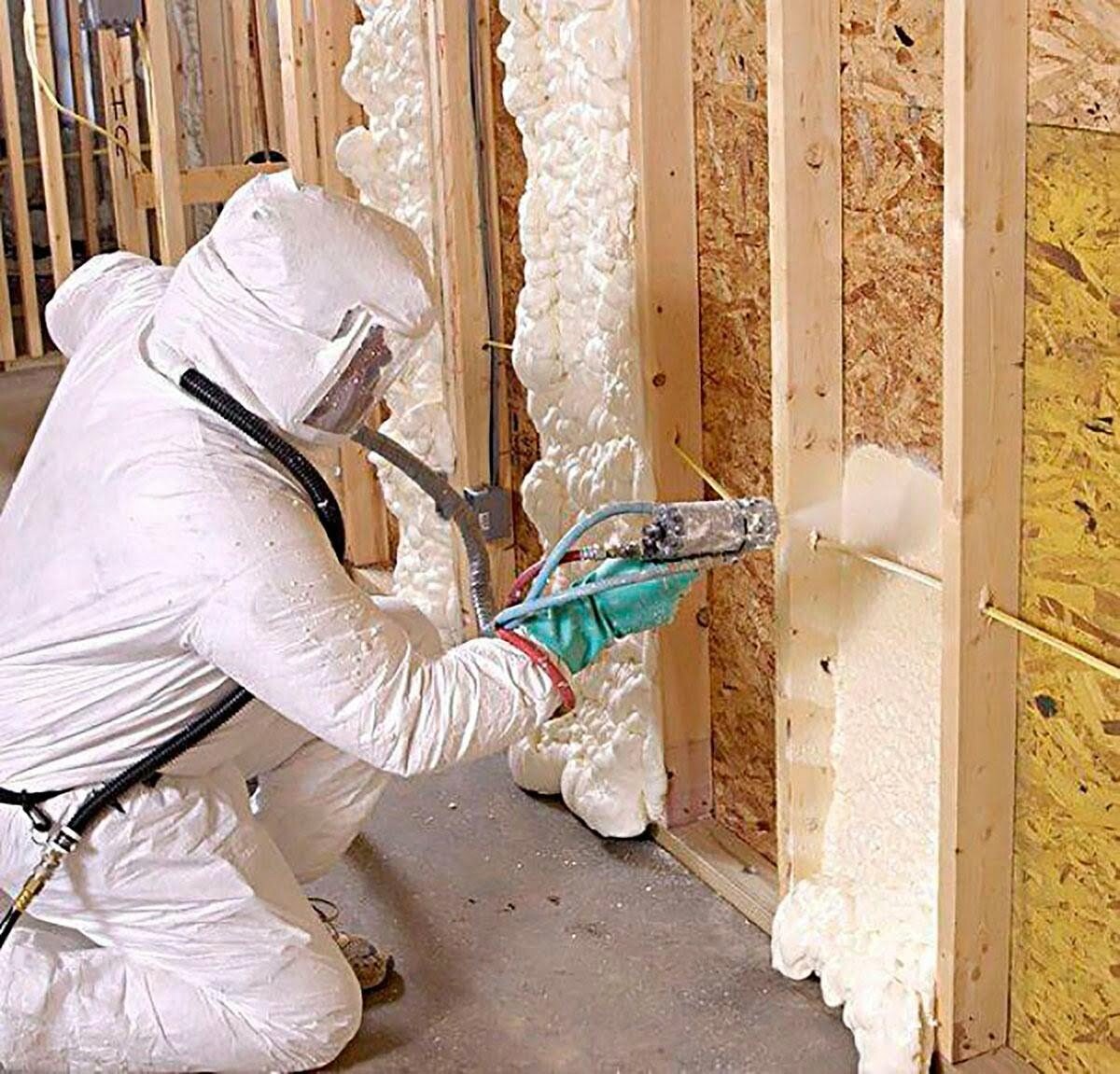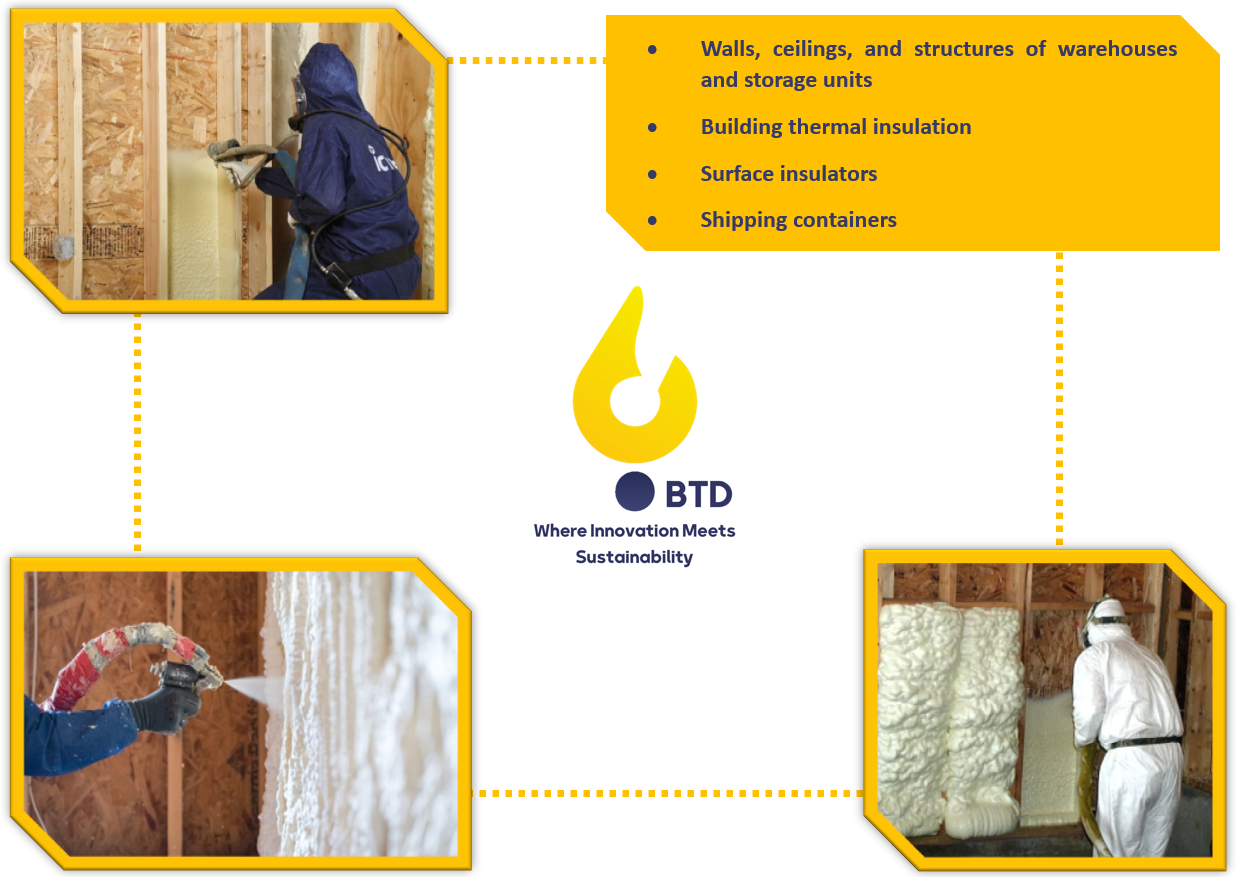Spray foam
Spray polyurethane foam is a type of rigid polymer foam used as thermal insulation in the building industry, warehouses, and storage facilities. The formulated polyols from Baspar Tose’e Davam Shimi, used in spray polyurethane foam, are a combination of polyether, polyester, and other additives. This company produces and supplies various flame-retardant systems, including B1, B2, and B3 (normal). They can manufacture different grades of polyols based on density and flame-retardant properties tailored to the customer's defined needs. We will now examine the technical parameters that influence the properties of polyols used in spray polyurethane foam.

Variety of Grades
| Specification | Unit | BATOPOL | |||
|---|---|---|---|---|---|
| SPF30B1 | SPF30B2 | SPF30-ES | |||
| Polyol Properties | Type | Flame retardant B1-rated | Flame retardant B2-rated | Flame retardant B2-rated | |
| Brookfield Viscosity | cps | 600±100 | 600±100 | 700±100 | |
| Cream time | sec | 3-5 | 3-5 | 3-5 | |
| Gel time | sec | 8-10 | 8-10 | 8-10 | |
| Tack Free Time | sec | 10-12 | 10-12 | 10-12 | |
| Free Rise Density | kg/m³ | 28-30 | 25-26 | 28-30 | |
| Foam Properties | Core Density in Foam | kg/m³ | 36-38 | 36-38 | 36-38 |
| Closed Cell Content | % | >90 | >90 | >90 | |
| Compressive Strength | kPa | >180 | >180 | >180 | |
| Dimensional Stability (-20 °C) | % | ≤2 | ≤2 | ≤2 | |
| Thermal conductivity (k-factor) | W/mK | 0.024 | 0.024 | 0.023 | |
| Fire Properties | B1 | B2 | B2 | ||
Applications

Spray Polyurethane Foam (SPF) is a highly versatile and energy-efficient insulation material widely used in construction and industrial applications. Made by mixing and reacting two chemical components, isocyanate and polyol resin, SPF expands upon application, creating a solid, seamless, and highly effective insulation layer. Its ability to provide superior thermal resistance, moisture control, and structural reinforcement makes it a preferred choice for both residential and commercial projects.
With the growing demand for energy-efficient buildings, spray polyurethane foam insulation has become an essential component in modern construction. Whether used in roofing, walls, or floors, SPF contributes to significant energy savings by reducing heat loss and air infiltration. This article explores the various aspects of SPF, including its types, applications, benefits, and unique properties.
What is Spray Polyurethane Foam?
SPF is a spray-applied plastic that creates a continuous barrier on walls, roofs, around corners, and other surfaces. The two primary components, isocyanate and polyol, mix at the spray nozzle, resulting in a rapid expansion that forms a durable insulating layer. The foam’s ability to adhere to different surfaces makes it a superior insulation solution compared to traditional materials.
There are two main types of spray polyurethane foam insulation:
1. Open-Cell SPF
Open-cell spray foam has a lower density and is less rigid than closed-cell foam. It consists of air-filled cells, making it softer and more flexible. Open-cell SPF is an excellent sound barrier and provides moderate insulation while allowing some breathability. It is often used in:
-
Interior walls
-
Ceilings
-
Attics
-
Soundproofing applications
2. Closed-Cell SPF
Closed-cell SPF is denser, more rigid, and has a higher R-value (thermal resistance) compared to open-cell foam. It provides superior moisture resistance, structural reinforcement, and energy efficiency. Due to its strong adhesion properties, closed-cell spray foam for insulation is widely used in:
-
Roofing applications
-
Exterior walls
-
Foundations
-
Cold storage units
-
Marine and vehicle insulation
Applications of Spray Polyurethane Foam
SPF has diverse applications across multiple industries due to its adaptability and performance. Some of the most common spray foam applications for roofing, insulation, and construction include:
1. Residential Insulation
SPF is extensively used for home insulation, including attics, crawl spaces, and walls. It helps regulate indoor temperatures, reduces energy bills, and enhances overall comfort. Unlike traditional insulation materials, SPF creates an airtight seal, preventing drafts and air leaks.
2. Commercial and Industrial Buildings
In commercial and industrial settings, polyurethane spray insulation enhances energy efficiency by minimizing heat transfer. It is commonly used in:
-
Warehouses
-
Cold storage facilities
-
Manufacturing plants
-
Office buildings
3. Roofing Systems
SPF is a popular choice for flat and low-slope roofs due to its seamless and waterproof nature. Spray foam application for roofing prevents leaks, strengthens the roof structure, and reduces cooling costs by reflecting sunlight.
4. Air Sealing and Moisture Barrier
SPF acts as an excellent air and moisture barrier, reducing the risk of mold growth and water damage. It is commonly applied around windows, doors, and other penetrations to enhance airtightness.
5. Transportation and Marine Industries
SPF is used in vehicle insulation, including trucks, trailers, and boats. It improves temperature control, reduces noise levels, and enhances durability against harsh weather conditions.
Benefits of Spray Polyurethane Foam
The benefits of spray polyurethane foam go beyond insulation, making it a preferred choice for a wide range of applications. Some of the key advantages include:
1. High Energy Efficiency
SPF significantly reduces energy consumption by minimizing heat loss and air leakage. Homes and commercial buildings using energy-efficient spray foam experience lower heating and cooling costs.
2. Moisture Resistance
Unlike traditional insulation materials that can absorb moisture and promote mold growth, SPF resists water infiltration, protecting structures from damage.
3. Structural Reinforcement
Closed-cell SPF adds strength to walls and roofs, enhancing the structural integrity of buildings. This additional reinforcement makes it ideal for hurricane-prone and high-wind regions.
4. Long Lifespan
SPF insulation lasts for decades without deteriorating, unlike fiberglass or cellulose insulation, which may sag or settle over time.
5. Improved Indoor Air Quality
By sealing gaps and cracks, SPF prevents allergens, dust, and pollutants from entering indoor spaces, resulting in healthier air quality.
6. Versatility
SPF can be used in various applications, from residential homes to industrial settings, making it a cost-effective and adaptable solution.
Unique Features of Spray Polyurethane Foam
-
SPF exhibits several unique characteristics that set it apart from traditional insulation materials:
-
Seamless Application: Eliminates gaps and thermal bridging.
-
Quick Installation: Can be applied rapidly, reducing construction time.
-
Adhesion to Various Surfaces: Bonds well with wood, metal, concrete, and other materials.
-
Fire Resistance: Some formulations contain fire-retardant additives for enhanced safety.
-
Soundproofing Properties: Helps reduce noise pollution in residential and commercial spaces.
-
Conclusion
Spray Polyurethane Foam (SPF) is a game-changer in the insulation industry, offering unmatched energy efficiency, durability, and performance. Whether used in residential, commercial, or industrial settings, polyurethane spray for construction provides a reliable solution for thermal insulation, moisture control, and structural enhancement.
As the demand for sustainable and energy-efficient solutions continues to grow, SPF remains a preferred choice for builders, contractors, and homeowners alike. Its ability to improve energy savings, enhance comfort, and extend the lifespan of buildings makes it an investment worth considering.
Frequently Asked Questions (FAQs)
1. What is Spray Polyurethane Foam (SPF) and how does it work?
2. What are the main benefits of using Spray Polyurethane Foam for insulation?
-
High energy efficiency: It reduces heat loss, lowering energy costs.
-
Air and moisture barrier: Prevents drafts, mold growth, and moisture damage.
-
Structural reinforcement: Strengthens walls and roofs.
-
Versatility: Can be applied on various surfaces, including wood, concrete, and metal.
